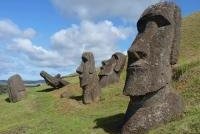
It is an unfortunate fact that long-anticipated visits to “iconic” WHS can often disappoint, but ours to Rapa Nui (Easter Island) most certainly did not! This, despite the fact that we had but a mere 7 hours ashore during a trans-Pacific cruise which took us on the “Heyerdal” sea route from the Peruvian coast taking 5 days on our cruise ship and then onward into “Polynesia proper”.
However you get there, Easter Island is an expensive and logistically awkward destination – most visitors will either fly through Papeete or do Santiago return. It certainly justifies more than the short day we gave it, but we were able to take in the main sites with reasonable free time. It would of course have been nice to return at different times of day for optimal photographic conditions and to have explored the less famous locations. On arrival you have the choice of minibus tours, private taxi, rent-a-car, bicycle or walking. We took the former in the morning and then a taxi in the afternoon. As regards walking and bicycle – well, it may look a mere “speck” on the World map, but it is a bit bigger “on the ground”! The main “town” of Hanga Roa is actually a very spread out village now full of restaurants, guest houses and the accoutrements of a tourist centre – just walking around it from your guest house could take a while but there are nearby walkable sites which could be very pleasant to reach along cliff paths. The other main sites are across the island and you would need to be prepared for a reasonable all day cycle ride to reach them.
So what did we see?
a. Ahu Tahai. Walkable just north of Hanga Roa so no problem to take in. It actually covers 3 different Ahu and Tahai is in the middle with its “restored” coral eyes.
b. Ahu Tongariku. 15 moai restored by anastylosis from both their late-moai cult destruction and by a major tsunami in 1960. Yes, it is almost entirely a reconstruction (it isn’t even known which moai were originally placed where), but its location in front of surf and cliffs is stunning, as is its size and scope
c. Rano Raraku. The quarry from which the moai were cut. A number remain still only half-formed in the living rock but all around are part buried (from forehead to waist) and toppled examples of fully formed ones at all sorts of angles to the ground, looking as enigmatic as you always expected them to be! If you were to cycle out from Hanga Roa you would have to be prepared to cover at least the 18kms to here – but the road follows the coast and you would pass 10 or more Ahu in various states of destruction some of which at least which would be interesting to stop at and explore (in our tour mini-bus we were unable to!) including examples of face-down and face-up topplings (a potentially historically significant difference apparently!). The site also provides fine distant views of Tongariku a bit further on. You will have to show (or obtain if you haven’t already done so) your National Park ticket (US $60 pp) here in order to get in.
d. Orongo. A ceremonial “village” used by the Bird-man cult of 18th and 19th Centuries which, at least partly, superseded the older moai cult. It is situated around 3kms SW of Hanga Roa along a dirt road – a foot path following the cliffs looked more interesting. The site is stunningly situated on a rocky promentary, high above the sea with a spectacular deep circular volcanic caldera on the other side. A series of dry stone constructed cult houses leads to a “high place” of rocks covered with “birdmen” petroglyphs. Far below lie the islands which the birdmen had to reach to collect the Sooty Tern egg before returning to the cliff top with it! WMF have just constructed a small visitor centre and exhibit here and again you will need a ticket to enter. Another “do not miss” site in my view.
It might have been nice to visit Anakena with its group of restored moai. It lies beyond Tongariki and also has a beach – but we are not “beach people” and made the decision (rightly I think) that we didn’t really “need” more moai but that Orongo was absolutely “necessary” to provide a rounded picture of Easter Island culture.
More on
Comments
No comments yet.
